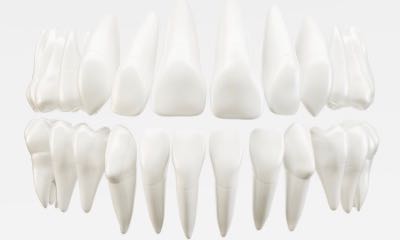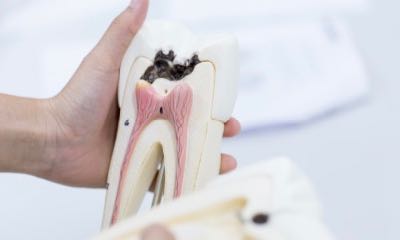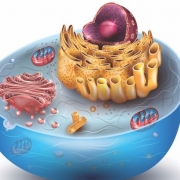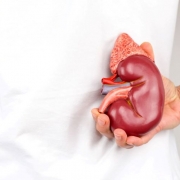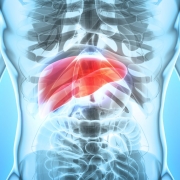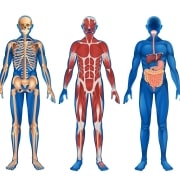All About Teeth: 24 Questions About Your Pearly Whites Answered

You use your teeth every day, but you might not know much about their anatomy. It’s time to start asking questions and learning more about them. Maybe “what are teeth made of?” has popped into your mind before. Or you’ve wondered from time to time: are your teeth bones?
It’s your lucky day.
You’ve found 24 bite-sized questions and answers to help you better understand your teeth. From baby teeth to teeth grinding, plaque, and flossing, this list has got it all. Study up so you can display your knowledge the next time you’re at the dentist.
- What Keeps Your Teeth in Place?
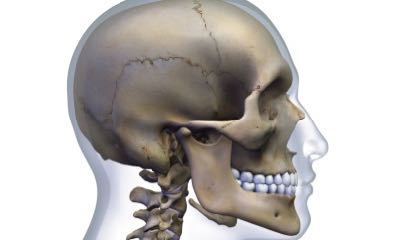
Your teeth are anchored into two of the bones of your skull. The upper teeth are situated in a bone called the maxilla that forms the upper jaw. And the mandible (jawbone) is the bone that houses your lower teeth.
The mandible and maxilla are the two bones that make up your jaw. They are connected on the right and left sides of your skull. Your jawbone is the strongest in your skull and the only one that can move. And that comes in handy when you bite and chew your food.
- How Many Teeth Do You Have?
Ancient philosophers like Aristotle once thought men and women didn’t have the same number of teeth. But we know better now. A full set of adult teeth for women and men is 32. You can count them yourself with your tongue.
Teeth are organized in pairs according to their shape. You have one tooth from the pair on each side of your mouth. Look in a mirror and see for yourself. Divide your mouth in half vertically to see that each side is virtually symmetrical.
- What is Your Tooth’s Crown? (Not the One from the Dentists, Either)
To answer this question, let’s breakdown the anatomy of a tooth.
Teeth are like icebergs. The iceberg appears to be a small chunk of ice floating in the water. When really, it’s like an ice mountain barely peeking up out of the ocean. So it is with your teeth. They exist above and below the surface of your gums. The shiny, white portion you can see when you open your mouth is called the crown.
This part of the tooth comes in contact with your food, drink, and saliva. It is the tough exterior that protects the whole tooth. So, a tooth’s crown is covered in a hard substance called enamel. Underneath the enamel is a layer of hard tissue called dentin.
- What is Enamel?
Until now, you probably thought that bone was the toughest tissue in your body.
Wrong!
That award goes to enamel. The hard, white material that surrounds the crown of your teeth takes the title.
Enamel is found on the outside of the tooth and made primarily of calcium phosphate. This mineral makes enamel incredibly strong. So, it can defend the softer, more sensitive layers of the tooth—dentin, pulp, nerves, and blood vessels. It also protects your teeth from the wear-and-tear of daily use.
- Do Teeth Have Roots?
They sure do. Below the hard crown is the tooth’s root. It’s tucked away underneath the gum line and tethered to the jawbone by connective tissue called the periodontal ligament.
Most of the root is made of dentin, which forms canals. They hold a living tissue called pulp that’s full of blood vessels and nerves that run through the root of the tooth and into the jawbone.
- Can Teeth Feel Sensations?
You might have noticed your teeth feeling sensitive to hot or cold temperatures. This can happen if the root of a tooth is exposed above the gum line, or if enamel wears down. When the dentin that makes up the root is uncovered, the nerves inside can be stimulated by the temperature of the food and drink in your mouth.
The sensations of hot and cold are transmitted through the nerves in the exposed dentin to the brain. Your brain interprets these signals as pain.
This is another reason enamel is so important. It acts like an insulator that shields teeth from extremely hot and cold temperatures. Enamel protects the sensitive nerves in dentin from painful stimulation.
- Why Do Teeth Come in Different Shapes?
Take one look at your smile and you’ll know your teeth don’t all look the same. In fact, your teeth vary widely in their shape and size.
While none of the teeth in your mouth are identical, they can be classified by their overall shape. An adult set of teeth has eight incisors, four canines, eight premolars, and 12 molars.
Beginning in the middle and branching out left and right are your incisors. These big front teeth are sharp like a knife. Next to the incisors are the canine teeth. They have a distinctive point called a cusp. They resemble the pointed teeth in dogs.
The next teeth in line are called the premolars. These teeth have two cusps and are sometimes referred to as bicuspids. Finally, the last class of teeth are the molars. They’re large and flat.
- What Do the Different Kinds of Teeth Do?
The different shape of each tooth helps it perform a specialized function while you chew your food.
Incisors are great at cutting into and holding chunks of food, like when you bite into an apple. Your incisors can also help you sense the texture of your food.
Canine teeth tear your food into smaller, more manageable pieces. You can put your canines to work by eating a piece of thick protein, like grilled chicken.
The premolars are between canines and molar in shape. Premolars help cut and tear food—much like the canine teeth do.
Molars are used for grinding food. As you chew, pieces of food are moved further back into your mouth where they’re ground up by your molars. Molars help break food into pieces you can swallow safely.
- What are Wisdom Teeth?
You have four wisdom teeth, which are also called third molars. They are shaped just like molars and perform the same tasks while you chew. But for some people, wisdom teeth need to be removed.
In your late teens and early twenties, wisdom teeth arrive. These are the last of your permanent teeth to erupt (another word for your teeth coming in). When wisdom teeth come to the surface, they can push against the other teeth, causing crowding and discomfort. They can even knock your other teeth out of alignment.
If your dentist believes your wisdom teeth will cause a problem, they’re often surgically removed. This procedure usually happens before the teeth erupt. Should you have your wisdom teeth removed, the number of permanent teeth in your mouth drops from 32 to 28. Don’t worry, you will get along just fine without your wisdom teeth. You might even be more comfortable.
- If Your Teeth are so Strong, How Can They Get Chipped?
The material that makes up most of your tooth enamel is called calcium phosphate. This mineral compound is also found in bones. It contributes to the white color of your teeth. And it’s incredibly strong and durable. But it isn’t indestructible.
Your teeth can get injured just like the rest of your body. If your tooth gets chipped or cracked, a dentist can repair the damage. But it will not heal on its own.
- Are Your Teeth Bones?
Even though they look a lot alike, teeth are not bones. And, surprisingly, they’re actually very different. Here’s how:
- Teeth are stronger than bone. As you know from above, enamel is the strongest tissue in your body.
- Bones are protected by layers of muscle and skin. Your teeth are covered only by your lips.
- Even though teeth are made of tougher material than bones, your bones can regenerate used and damaged tissue. When it comes to enamel, once it is gone it doesn’t come back.
- Both bones and teeth have blood vessels and nerves inside them. But unlike teeth, bones actually produce new blood cells in their bone marrow. Teeth have an inner layer similar to marrow. This is the pulp layer that is protected by tooth enamel.
- What is the Color of a Healthy Tooth?
Healthy teeth are bright and white. Their color comes from the calcium phosphate in enamel. The tips and edges of teeth may appear translucent or blue-tinted. This is perfectly normal.
Yellowing of teeth can indicate enamel loss. Dentin, the layer underneath enamel, is yellow. When enamel wears down and dentin is exposed, the tooth can become discolored and appear yellow.
Fortifying your enamel with calcium rich foods—like milk, yogurt, almonds, and edamame—can help restore its whiteness. You can also drink fluoridated water to support the health of your enamel. Fluoride reinforces enamel and keep the yellow dentin from being exposed.
- How Many Teeth Do Children Have?
Little children have 20 primary (or baby) teeth. They are eight incisors, four canines, and eight molars. These teeth are shed later to make room for larger, permanent teeth. By age three, most children have each of their primary teeth.
Baby teeth are made of the same materials as permanent teeth. Enamel covers the crown, and the root is made of dentin and pulp. Primary teeth are smaller and more spaced out than permanent teeth. This is because the bones of the face and jaw grow as the child gets older, causing teeth to spread out.
- When Do Teeth Start Developing?
Before you were born, your teeth were forming. Between the third and fourth month of pregnancy, cells called ameloblasts generate the enamel that forms teeth. This happens around the tooth bud (the first stage of tooth development). These buds stay below the surface of the gums until fully formed—anywhere from six months to a year after birth.
- Why Do Teeth Fall Out?
As a child, your teeth fall out so larger, adult teeth can take their place. This is a natural and healthy part of the lifecycle of your teeth. Most primary teeth will fall out by age 12.
Tooth loss happens when the roots of primary teeth dissolve in preparation for the arrival of permanent teeth. This process can take several weeks, and it’s best to let teeth fall out on their own. After a primary tooth is out, a new permanent tooth will erupt in the same spot.
- What are Cavities?
Just like their name implies, cavities are tiny holes in the enamel and dentin layers of teeth. Cavities are the result of tooth decay, which happens when bacteria invade broken or damaged teeth.
Simple sugars are the main culprits behind cavities. Soda, juice, candy, and similar foods can linger on teeth. The bacteria in your mouth can turn these simple carbs into acids that erode the enamel on your teeth. And a cavity is born.
You might notice that you have a cavity on your own. Many people experience toothache and discomfort when they have a cavity. Your tooth might be especially sensitive to temperature or ache when you eat something sweet.
Sometimes it takes a trip to the dentist to find a cavity. With x-ray imaging the dentist can see cavities between your teeth. They can also use dental equipment to look for soft spots and holes on the tooth’s surface.
Fortunately, dentists can fix cavities with a dental filling. First, the dentist removes the decayed portion of tooth with a small drill. Then they replace the missing part of the tooth with a safe material. Fillings can be made of gold, silver, porcelain, or a composite resin. After a filling, your tooth will feel much better.
- What is Plaque?
If your teeth feel fuzzy after eating, plaque is to blame. When you eat sugary foods, the bacteria in your mouth cling to your teeth and feast on the simple carbohydrates. These bacteria can form a sticky film on the surface of your teeth called plaque.
You can easily remove plaque. Brushing your teeth is the best way to get rid of plaque. Do it twice a day for best results. Rinse your mouth with anti-bacterial mouth wash to keep the number of bacteria in your mouth under control. And consider an oral probiotic to help support a healthy bacteria balance.
- What is Tartar?
Plaque that stays on teeth can harden into tartar—a tough, mineralized substance. When tartar is present, cavities can soon follow. And tartar makes it difficult to brush properly. It requires a professional dental cleaning to remove.
Plaque generally forms above the gum line, but tartar can build up above and below the gums. This can cause problems for the dentin and bone underneath your gums. That’s why it is so important to take care of your teeth to avoid tartar build up.
You can protect your teeth from tartar by brushing and flossing daily and using mouthwash. Another great way to keep tartar at bay is fortifying your enamel with fluoride. This mineral is found in most municipal water systems. It strengthens enamel and helps repair damage caused by the bacteria and acids in your mouth.
- Why Should You Brush Your Teeth?
For thousands of years people have been brushing their teeth. Ancient Egyptians in 5,000 B.C. used frayed twigs and egg shells to polish their teeth. Now toothbrushes with soft bristles clear away the food left behind after a meal.
Brushing your teeth is the best way to keep cavities away. You should brush your teeth twice a day with a pea-sized amount of toothpaste. Be gentle when you brush. Scrubbing hard with a toothbrush can irritate the gums and expose the sensitive dentin underneath.
Two minutes is the perfect amount of brushing time. Keep a timer or clock in your bathroom to help measure how long you brush. Switch sides often and cover the front and back of each row of teeth.
Change your toothbrush when it wears out. Every three to four months is recommended. Rinse your toothbrush with hot water after each use. And get a new toothbrush after you’ve been sick.
- Is Flossing Important?
Absolutely! Brushing cares for the parts you can see. But you need to clean between your teeth, too. Using dental floss loosens up food and plaque. It keeps tartar from building up in hard-to-reach areas. Flossing also cleans the parts of your teeth hidden below your gum line.
Floss every day to keep the areas between your teeth healthy and clean.
- How Can You Help Avoid Tooth Decay?
Brushing and flossing are the best ways to keep your teeth healthy and your enamel in good shape. But your diet can play an important role in helping avoid tooth decay.
Steer clear of soda, juice, and other sugary drinks. These are the most harmful. So, drink water instead. Simple carbohydrates and starchy foods should be limited. When you want something sweet, skip the candy. Look to fruits for their natural sweetness as an alternative. Their high fiber content stimulates saliva production and washes sugar off your teeth. Acidic foods—like citrus fruits—can erode enamel over time, so make sure to drink plenty of plain water when consuming them.
Foods rich in calcium like milk, yogurt, and cruciferous vegetables are great for your teeth. Celery and other crunchy vegetables help clean your teeth of debris. And follow the same advice for your teeth as you do for your waistline. That means choosing whole foods and nutritious meals over simple, sugary snacks.
- What is Bruxism?
Part of caring for your teeth is managing stress. Stress might tense you up and make you clench your fists. Some people also clench their jaw. This can lead to a condition called bruxism, or teeth grinding.
Bruxism can happen during sleep, so people who grind their teeth are often unaware of it. But grinding can lead to excessive wear on the flat portions of your teeth. It can also cause jaw soreness and headaches.
Your dentist can tell you if you grind your teeth. They might recommend wearing a mouthguard at night to keep your teeth from grinding together.
But there are other ways to fight bruxism. Try deep breathing exercises before bed. Hold a warm washcloth on your cheek just below the ear to help relax the muscles in your face and jaw. Place the tip of your tongue between your front teeth to open and relax your jaw.
If you’re stressed, open up to someone. Sharing your thoughts and feelings with a trusted friend or mental health professional can help manage your stress or anxiety. You might notice you sleep better and stop grinding your teeth.
- Can Your Teeth Give You Bad Breath?
Poor oral hygiene is usually the root of bad breath. When you skip brushing or flossing, the bacteria in your mouth go to town on the food lingering on your teeth. The breakdown of sugars and starches by bacteria creates some foul-smelling odors.
Sometimes the food you eat is the source of your stinky breath. Garlic and onions are notorious for leaving bad breath behind. Spicy foods can also share the blame.
Whether your bad breath is caused by bacteria or the food you ate, the best way to eliminate it is brushing and flossing. Brush twice a day to keep your breath fresh. If you eat a particularly pungent meal, gently clean your teeth afterward, too.
- Are Your Teeth Unique?
It may come as a surprise, but just like your DNA and fingerprints, your teeth are unique. No one has the same teeth you do. Their shape, size, and placement vary from person to person. Not even identical twins have the same set of teeth!
Keep Your Teeth Bright and Gleaming
Show your teeth some respect by making sure they’re in good shape. Keep them healthy by taking proper care of them. Brush and floss daily. Avoid sugary foods that erode your enamel. And visit the dentist regularly.
Smile, because there aren’t any other teeth in the world like yours.
About the Author
Sydney Sprouse is a freelance science writer based out of Forest Grove, Oregon. She holds a bachelor of science in human biology from Utah State University, where she worked as an undergraduate researcher and writing fellow. Sydney is a lifelong student of science and makes it her goal to translate current scientific research as effectively as possible. She writes with particular interest in human biology, health, and nutrition.
References
https://www.webmd.com/oral-health/picture-of-the-teeth#2
https://www.mouthhealthy.org/en/fun-teeth-facts
https://www.webmd.com/oral-health/guide/tooth-enamel-erosion-restoration#1
https://www.verywellhealth.com/top-facts-your-dentist-wants-you-to-know-1059131
https://www.livescience.com/33130-why-are-teeth-not-considered-bones.html
https://www.ncbi.nlm.nih.gov/pmc/articles/PMC2798600/
https://www.colgate.com/en-us/oral-health/conditions/bad-breath
https://www.colgate.com/en-us/oral-health/basics/fluoride/what-does-fluoride-do-0316
https://www.healthline.com/health/how-many-teeth-do-adults-have#4
https://www.parents.com/kids/hygiene/tooth-care/losing-baby-teeth/





